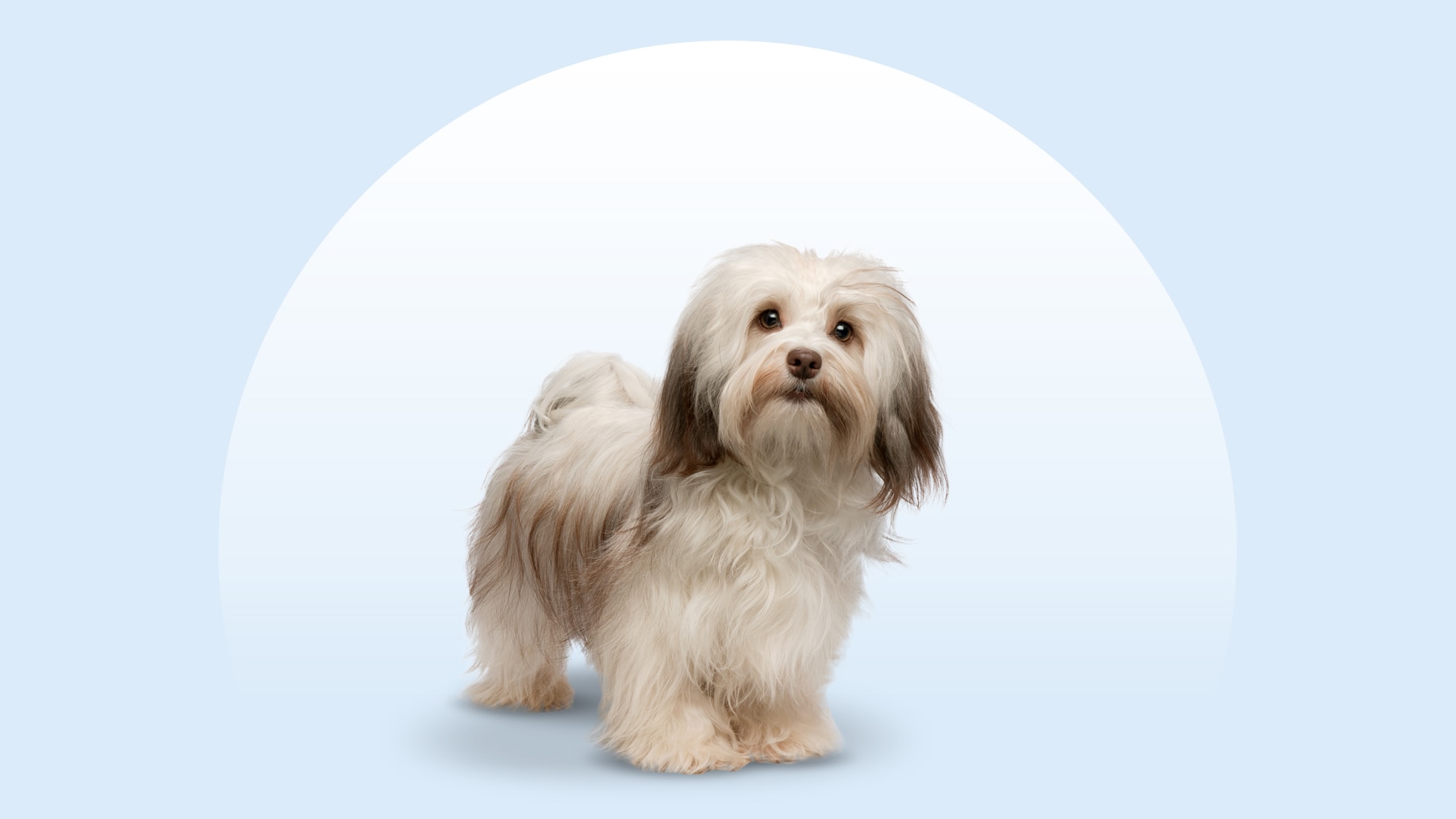Havanese
Updated December 15, 2025
Havanese
Updated December 15, 2025
A doting, delightful dog who loves attention, the Havanese is a cheery small dog. These bite-sized mood boosters are a great fit for almost any home, especially if it’s as lively and social as they are.
Adoring, Cheery, Social
7–13 pounds
8.5–11.5 inches
14–16 years
White, Black, Black Brindle, Chocolate, Cream, Fawn, Gold, Gold Brindle, Gold Sable, Red, Red Sable, Red Brindle, Silver, Silver Brindle, Black and Tan, Black and Silver
If your Havanese took a personality test, they’d be a solid ESFJ—a delightful extrovert who charms everyone with their winning attitude.
Their long, silky hair might be one of their cutest features, but Havanese dogs are less concerned with looking adorable and more curious about everything around them—like that flower over there, and that new person by the bench, and whatever their best friend (that’s you) is doing.
Playful and kind, Havanese thrive in almost any environment as long as they’re on the receiving end of round-the-clock affection and attention.
Havanese Characteristics
Havanese Appearance
A silky tail curls over the Havanese’s back and wags happily as you walk through the door. With an intelligent face and soft double coat, their dark brown eyes are warm and bright.

- Ears
Havanese ears are broader at the base and set high on the head. When sitting at attention for treats or listening for the sound of keys in the door, they lift but remain folded over.
- Eyes
Havanese eyes are large and almond-shaped. They’re almost always dark brown and lined in solid black. But in chocolate-colored dogs, they’re sometimes lighter and lined in brown.
- Nose
Their broad nose is solid black on most Havanese dogs, but for those with a chocolate-colored coat, it’s solid brown.
- Coat Length
Havanese have a long, silky double coat.
- Coat Color
Havanese colors include black, black and silver, brown, silver, fawn, red brindle, black brindle, and white. They can also have many marking patterns, including cream, white, tan, and even different-colored markings throughout their coat.
- Tail
Their long, silky tail curls over their back and wags with ease.
Havanese Temperament
There are so many things to do and see in the world, yet your Havanese’s favorite place is with their favorite person—lucky you! Whether you’re watching a movie or folding laundry, you have their attention, and they find you fascinating.
However, this doesn’t mean they’re a homebody. On the contrary, this friendly dog wants to see the world and meet new people. If you, too, think that strangers are just friends you haven’t met yet, you’ve met your soul pup.
These social butterflies will make new acquaintances every time they go on a walk, whether two- or four-legged. While Havanese dogs look dainty, they’re sturdier than they seem and have enough energy for at least a couple of neighborhood sprints a day. The most agile Havanese may love dog sports like agility, too.
These bright pups will let you know when they’re feeling playful; they might drop a favorite dog toy at your feet and cock their head to announce it’s time for a game of fetch.
When it comes to training, it’s easy-peasy. Because they’re very smart dogs and eager to please (and learn!), most Havanese pick up simple cues quickly.
And if you have other furry friends in the house, no worries. When it comes to the Havanese, the more friends, the merrier. Just make sure everyone is introduced and socialized properly.
How to Care for a Havanese
Many Havanese will need daily brushing, but this just gives you extra time to bond. They’ll also need training (either with your guidance or in a class with other pups), along with a moderate exercise routine.
Grooming
Training
Diet
Exercise
Environment
Havanese Health
The Havanese lifespan is 14–16 years. Here are some health issues to be aware of.
- Heart issues: Havanese are prone to heart murmurs. A heart murmur is the earliest sign of mitral valve disease, which results in the heart muscle becoming enlarged and pumping blood inefficiently. If your pup has a murmur, your vet will likely refer them to a veterinary cardiologist for an echocardiogram (ultrasound of the heart).
- Hip dysplasia: Hip dysplasia is when the hip and thigh bones don’t properly fit, leading to a loose joint and (eventually) arthritis and pain. More severe cases may require surgery, but hip dysplasia is often treated with medications, joint supplements, special diets, weight management, and/or physical therapy.
- Legg-Calve-Perthes disease: A rare and likely genetic disease that causes bone death in the head of the femur and significant changes to the hip joint, Legg-Calve-Perthes disease usually develops in a pup’s first year of life, causing pain and limping. Serious cases may require surgery, but most Havanese puppies make a full recovery.
- Luxating patella: Havanese can develop a luxating patella, where the kneecap slips out of place. You might notice that they do a little bunny hop or skip—this could be a symptom. It may be treated with supplements and meds, if mild, though surgery may be needed. Keeping your dog at a healthy weight can help prevent this condition.
- Osteochondrodysplasia: Havanese are susceptible to osteochondrodysplasia, a genetic disorder that affects bone and cartilage development. This can be minor, in which case no treatment is necessary; otherwise, pain meds are a good option, if needed.
- Progressive retinal atrophy (PRA): PRA leads to blindness in dogs, and while there is no cure, pups who lose their eyesight tend to adapt well and can still live full, happy lives.
Havanese History
Named after the capitol city of Havana, these dogs’ ancestors first gained favor in 1500s Cuba, where they were the favorites of wealthy farmers and the aristocracy. Unlike many canines of the time, Havanese weren’t working dogs; instead, they lived a life of leisure—just like most dogs today.
Legends vary regarding Havanese origin, but it’s fairly certain that Poodles from Europe visited the island in the 19th century, and the resulting crossbreed is today’s modern Havanese. It’s also believed that the Havanese’s ancestors include the Bichon Frise and the Maltese.
What’s certain is that the little dogs only became more popular since their origin. In fact, famous English novelist Charles Dickens and famous American novelist Ernest Hemingway were both fond of the dogs.
During the Cuban Revolution in the late 1950s, emigrants brought their dogs abroad, and the Havanese was recognized by the American Kennel Club in 1996.
Typically, Havanese puppies cost between $1,800–$2,500. If you choose this route, pick a responsible breeder.
You can also look into Havanese adoption, as there are many puppies and adult dogs patiently waiting for forever homes. Check out a Havanese rescue like Havanese Rescue Inc., keep an eye out at your local animal shelter or rescue, or search Chewy’s database of adoptable dogs in your area.








